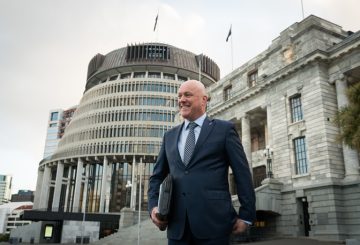Sebuah sekolah di Northland, Selandia Baru meminta pemerintah untuk mempertimbangkan kembali rencananya untuk mengurangi program makan siang gratis. Program yang disebut Ka Ora, Ka Ako, melayani sekitar 230.000 siswa sehari di hampir 1000 sekolah di seluruh negeri. Pemerintah sedang mempertimbangkan untuk memotong dana program hingga 50 persen dalam Anggaran bulan depan. Menteri Kesehatan Asosiasi David Seymour telah mempertanyakan efektivitas dan nilai program bagi pembayar pajak.
SMA Tikipunga di Whangārei adalah salah satu sekolah yang khawatir tentang potensi pemotongan. Kepala sekolah, Emma Leyland, mengatakan makan siang gratis telah secara signifikan meningkatkan kehadiran dan perilaku siswa. Sekolah mulai menawarkan makanan sehat 10 tahun yang lalu, tetapi harus bergantung pada sumbangan makanan. Sejak 2019, program Ka Ora, Ka Ako telah memungkinkan sekolah menyediakan makanan bergizi untuk setiap siswa setiap hari.
Laporan Departemen Keuangan tahun lalu tidak menemukan bukti peningkatan prestasi atau kehadiran di sekolah-sekolah yang menerima makan siang. Namun, Leyland mengatakan program ini telah membawa manfaat besar bagi sekolahnya, termasuk peningkatan kehadiran, prestasi, perilaku, dan hubungan. Dia juga mencatat bahwa program ini telah membantu keluarga yang berjuang dengan biaya hidup yang tinggi dan telah mendorong anak-anak untuk pergi ke sekolah.
Siswa kelas 13 Aamea Walding-King mengatakan banyak anak mengandalkan makan siang sekolah sebagai sumber makanan utama mereka untuk hari itu. Siswa Kelas 13 lainnya, Kaian Burt, mengatakan makan bersama juga memberikan kesempatan bagi siswa untuk merenungkan pekerjaan mereka dan bersosialisasi dengan teman-teman.
Direktur Eksekutif Koalisi Kesehatan Aotearoa Faye Langdon mengatakan makan siang gratis memungkinkan anak-anak untuk bersekolah dan mencapai prestasi, terutama di daerah dengan kekurangan tinggi. Kelompoknya telah mengumpulkan 26.000 tanda tangan yang menyerukan agar program tidak hanya dipertahankan tetapi juga diperluas.
Di sisi lain, Seymour mengatakan 10.000 makan siang terbuang setiap hari dan tidak ada bukti nyata program tersebut meningkatkan kehadiran atau prestasi sekolah. Dia menambahkan bahwa pemerintah berkomitmen untuk meningkatkan efektivitas biaya program makan siang sekolah. Seymour akan mengumumkan program yang menguntungkan siswa dan pembayar pajak dalam Anggaran mendatang.
Program Ka Ora, Ka Ako menargetkan sekolah-sekolah di mana siswa menghadapi hambatan sosial ekonomi terbesar dan kemungkinan besar tiba di sekolah dengan kelaparan. Di Northland, program ini melayani sekitar 18.000 siswa di 115 sekolah. Sekolah dapat memilih untuk membuat makan siang sendiri atau mengontrak pemasok eksternal.


















































-360x245.jpg)









